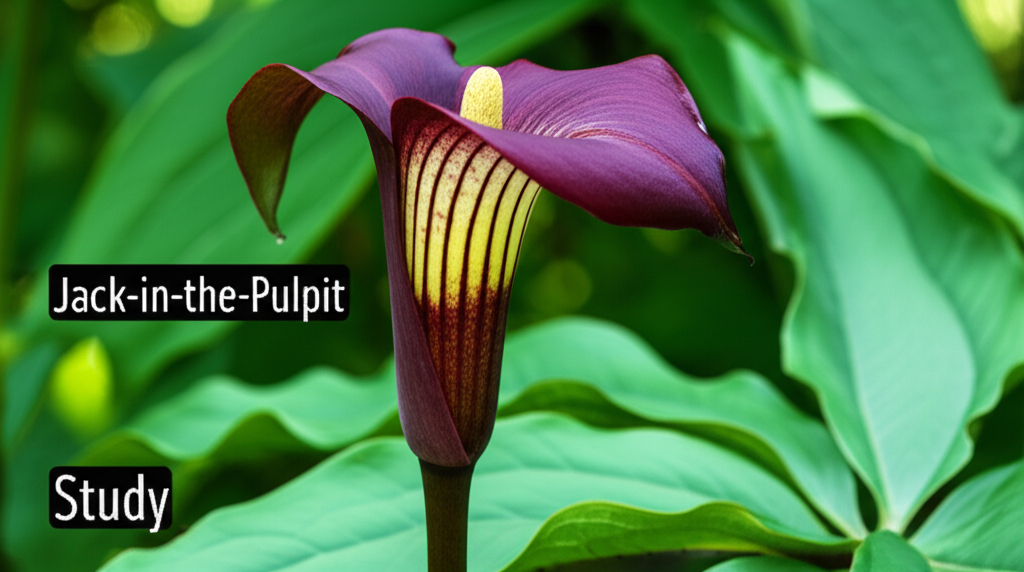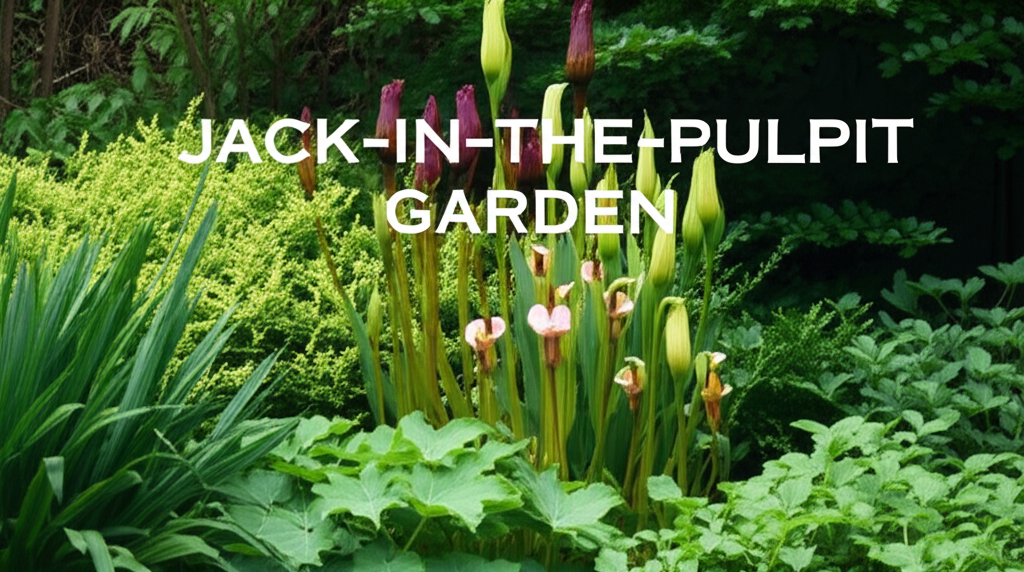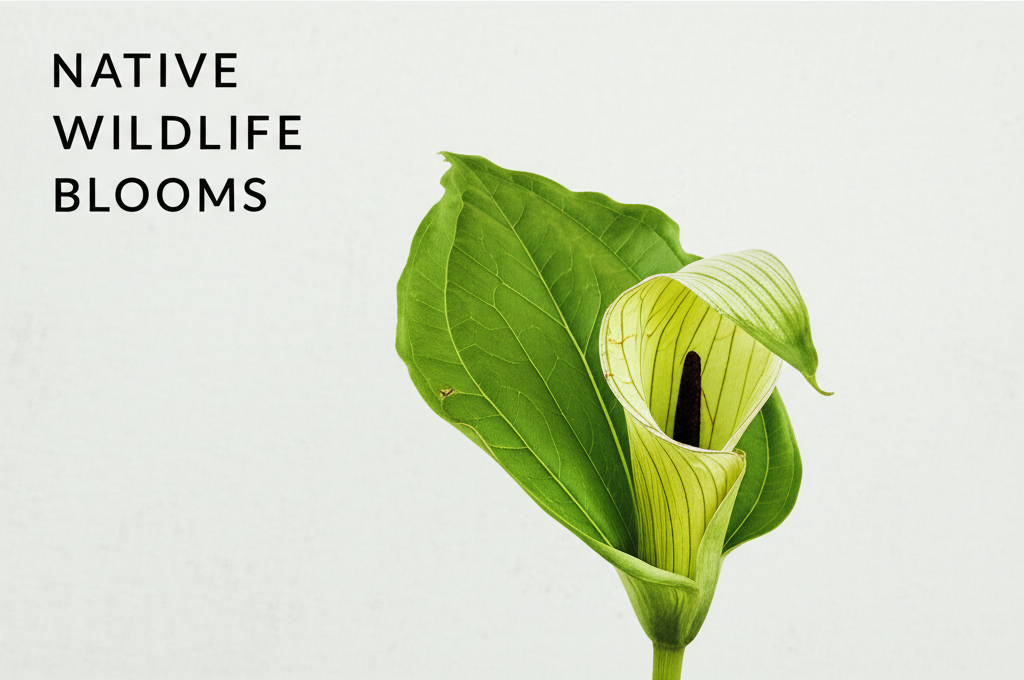The Allure of the Jack-in-the-Pulpit: A Botanical Marvel
The Jack-in-the-Pulpit, scientifically known as Arisaema triphyllum, is a captivating woodland perennial that never fails to spark curiosity. Its common name conjures an immediate image: a hooded “pulpit” sheltering a “jack.” This unique structure is not merely ornamental; it’s a sophisticated evolutionary adaptation designed for successful reproduction in the shaded understory of North American forests. Beyond its striking visual appeal, the Jack-in-the-Pulpit presents a fascinating subject for morphological and symmetry studies, revealing intricate details about plant development and ecological interactions.
This article will delve into the complex morphology of the Jack-in-the-Pulpit, dissecting its various parts and exploring the principles of symmetry that govern its form. We will examine its reproductive strategies, the environmental factors influencing its development, and the scientific interest it continues to generate.
Understanding the Morphology: Deconstructing the Jack-in-the-Pulpit

The term “morphology” refers to the study of the form and structure of organisms. For the Jack-in-the-Pulpit, understanding its morphology is key to appreciating its unique adaptations. The plant typically arises from a corm, a thickened underground stem that serves as a storage organ. From this corm, one or two erect scapes (flower stalks) emerge, each typically bearing two or three trifoliate leaves.
The Inflorescence: A Masterpiece of Adaptation
The most distinctive feature of the Jack-in-the-Pulpit is its inflorescence, a reproductive structure enclosed within a modified leaf known as a spathe. This spathe, often referred to as the “pulpit,” is a large, hood-like sheath that enfolds the spadix, the fleshy central spike.
The Spathe: The “Pulpit” Itself
The spathe is a highly modified bract that plays a crucial role in attracting pollinators. It is typically green, often with purplish or brownish streaks, and can vary in size and shape depending on the individual plant and its growing conditions. The upper part of the spathe curves over to form the characteristic hood, creating a shaded chamber. The inner surface of the spathe is often smooth, while the outer surface can be ribbed or veined.
The Spadix: The “Jack” Within
The spadix is the true flower-bearing structure, a fleshy spike that emerges from the center of the spathe. At the base of the spadix are the female flowers, followed by the male flowers higher up. The uppermost part of the spadix, often referred to as the “club” or “ear,” extends beyond the spathe and is usually sterile. This club-like appendage is believed to aid in attracting pollinators and may also play a role in directing them into the spathe chamber.
The Leaves: Essential for Photosynthesis
The leaves of the Jack-in-the-Pulpit are compound, meaning they are divided into leaflets. Typically, each scape bears two leaves, and each leaf is further divided into three leaflets (hence the specific epithet triphyllum, meaning “three-leaved”). These leaflets are ovate to lanceolate in shape, with pointed tips and smooth or slightly wavy margins. They are attached to the scape by a petiole, which is a leaf stalk. The arrangement of these leaves is crucial for maximizing light capture in the dappled shade of the forest floor.
Symmetry in the Jack-in-the-Pulpit: A Study in Botanical Geometry
Symmetry, the balanced arrangement of parts around an axis or center, is a fundamental principle in biology. While plants often exhibit a degree of radial or bilateral symmetry, the Jack-in-the-Pulpit presents a more complex scenario, particularly concerning its inflorescence.
Radial Symmetry in General Plant Structure
On a broad level, many plant structures exhibit radial symmetry. For example, a cross-section of a stem or root often shows a roughly circular arrangement of tissues. However, when we examine the Jack-in-the-Pulpit’s individual components, more specific types of symmetry become apparent.
Bilateral Symmetry in the Spathe and Spadix
The spathe, due to its hooded structure and the way it partially encloses the spadix, exhibits a strong degree of bilateral symmetry. If you were to draw a vertical line down the center of the spathe, the two halves would be largely mirror images of each other. Similarly, the spadix, with its distinct parts arranged along a central axis, also demonstrates bilateral symmetry. This bilateral symmetry is particularly important for insect visitors, as it provides a predictable entry point into the spathe chamber.
Functional Implications of Symmetry
The symmetry of the Jack-in-the-Pulpit’s inflorescence is not merely aesthetic; it serves crucial functional purposes related to pollination. The hooded spathe, with its bilateral symmetry, creates a contained environment. This enclosure, along with the specific arrangement of flowers and the potential scent emitted, attracts small flies, gnats, and other crawling insects.
The spadix, with its smooth lower surface and the downward-pointing hairs on the male flowers, helps to trap these insects within the spathe. The spadix’s club-like apex might further guide insects towards the central reproductive parts. Once trapped, the insects are forced to crawl over the female flowers at the base, facilitating pollination, before eventually finding their way out through the opening at the top. This intricate design, rooted in precise morphological and symmetrical arrangements, ensures the plant’s reproductive success.
Key Morphological Features and Their Significance
To further understand the Jack-in-the-Pulpit, let’s summarize its key morphological features and their ecological importance.
| Feature | Description | Significance |
|---|---|---|
| Corm | Underground storage organ | Energy reserve for growth and reproduction; survival through winter |
| Scape | Erect, leafless flower stalk | Supports inflorescence and leaves, elevating them for visibility and pollination |
| Leaves | Compound, trifoliate (3 leaflets) | Photosynthesis; broad surface area for capturing light in shaded environments |
| Spathe | Modified leaf, forming a hooded sheath | Protects inner floral structures; attracts pollinators; creates a pollination chamber |
| Spadix | Fleshy central spike bearing flowers | Contains male and female flowers; specialized surface to trap pollinators |
| Spadix Club | Sterile, often club-shaped apex of the spadix | May aid in attracting or directing pollinators |
Sexual Dimorphism and Development: A Unique Life Cycle
A fascinating aspect of the Jack-in-the-Pulpit’s morphology is its sexual dimorphism and a unique developmental pathway known as protogynous hermaphroditism.
Protogynous Hermaphroditism Explained
Many Jack-in-the-Pulpit plants are monoecious, meaning they have both male and female reproductive organs. However, they do not self-pollinate. Instead, they exhibit protogyny, where the female flowers mature and become receptive before the male flowers. This temporal separation of sexes is a strategy to prevent self-fertilization.
Sex Change: A Flexible Strategy
Even more remarkably, Jack-in-the-Pulpit plants can change their sex over their lifetime. Small, weakly growing plants tend to be functionally male, producing pollen. As they accumulate more resources from photosynthesis, they can transition to being functionally female, producing seeds. If resource availability declines in subsequent years, they may revert to being male. This flexibility in sex expression is a significant adaptation, allowing the plant to optimize reproductive output based on environmental conditions and energy reserves.
This sex change is not a physical transformation in the traditional sense but rather a shift in the development and function of the floral organs. Young plants, with less stored energy, focus on pollen production, maximizing their chances of contributing genes to the next generation. Larger, well-nourished plants can invest more energy into seed production, a more resource-intensive process.
Studying the Jack-in-the-Pulpit: Methods and Observations
Botanists and researchers employ various methods to study the morphology and reproductive biology of the Jack-in-the-Pulpit.
Field Observations and Collections
Direct observation in its natural habitat is fundamental. Researchers document the size and shape of spathes, spadices, and leaves, noting variations across different populations and environmental conditions. Collecting specimens allows for detailed microscopic examination and preservation for future study.
Laboratory Analysis
In the lab, techniques such as dissection, microscopy, and even anatomical staining are used to analyze the internal structure of the inflorescence and vegetative parts. This can reveal the precise arrangement of floral organs, vascular tissue, and cellular structures.
Pollination Studies
Controlled experiments are often conducted to identify specific pollinators and understand their behavior within the spathe. This may involve observing insect visits, using cameras to record interactions, or analyzing pollen carried by insects.
Growth and Sex Expression Studies
Long-term monitoring of individual plants can track their growth patterns and any changes in sex expression over several years. This helps to elucidate the relationship between resource availability and reproductive strategy.
Comparative Morphology: Jack-in-the-Pulpit vs. Other Araceae Members
The Jack-in-the-Pulpit belongs to the Araceae family, commonly known as the aroid family. This family is renowned for its characteristic inflorescence: the spadix and spathe. Comparing the Jack-in-the-Pulpit’s morphology to other aroids highlights shared adaptations and unique specializations.
The Spadix-Spathe Unit in Araceae
Across the Araceae family, the spadix and spathe are nearly universal features, though their form and function vary widely. In many aroids, like the Peace Lily (Spathiphyllum) or the Calla Lily (Zantedeschia), the spathe is typically a showy, often white or colorful, petal-like structure that serves primarily to attract pollinators. The spadix, in these cases, may be brightly colored or fleshy and can be laden with nectar.
Differences in Pollination Strategies
While the Jack-in-the-Pulpit employs a “trapping” mechanism, many other aroids utilize different strategies. Some release strong scents to attract specific pollinators, while others offer rewards like nectar or pollen. The Jack-in-the-Pulpit’s subtle scent and its reliance on crawling insects differentiate it from aroids that attract larger flying insects with vibrant colors and potent perfumes.
The Jack-in-the-Pulpit’s Unique Sex Change
The ability of the Jack-in-the-Pulpit to change sex is a particularly noteworthy trait, not commonly observed with the same degree of flexibility in many other aroid species. This highlights the diverse evolutionary pathways taken within this large plant family.
Factors Influencing Morphology: Environment and Genetics
The morphology of the Jack-in-the-Pulpit is a product of both its genetic makeup and the environmental conditions it experiences.
Environmental Influences
- Light Availability: Plants growing in deeper shade may have larger spathes and scapes to maximize light capture and visibility.
- Soil Moisture and Nutrients: Optimal soil conditions support more robust growth, leading to larger plants, potentially larger inflorescences, and a greater likelihood of developing into functionally female plants.
- Temperature: Growing season length and temperature fluctuations can influence the timing of flowering and the overall development of floral structures.
Genetic Predisposition
While environmental factors play a significant role, there are also inherent genetic differences between populations of Jack-in-the-Pulpit that can influence their morphology. These genetic variations can lead to subtle differences in spathe color, size, and the precise shape of the spadix.
Pros and Cons of the Jack-in-the-Pulpit’s Morphological Adaptations
The unique structure and reproductive strategy of the Jack-in-the-Pulpit come with distinct advantages and potential disadvantages.
| Aspect | Pros | Cons |
|---|---|---|
| Spathe-Spadix Inflorescence | Effective in attracting and trapping specific pollinators; protects floral organs from harsh weather; creates a controlled pollination environment. | Relies on specific insect behavior; may not attract a wide range of pollinators; potential for trapping non-pollinating insects that consume pollen or nectar. |
| Protogynous Hermaphroditism and Sex Change | Prevents self-pollination, promoting genetic diversity; allows adaptation to resource availability by prioritizing pollen or seed production. | Sex change can be energetically costly; if pollinators are scarce, a functionally female plant might not receive enough pollen to set seed; dependence on specific conditions for successful sex transition. |
| Corm as Storage Organ | Allows survival through winter and unfavorable conditions; provides energy reserves for rapid spring growth and flowering. | Can make the plant susceptible to soil disturbance and corm predation; requires sufficient stored energy to initiate growth each year. |
Conclusion: A Testament to Evolutionary Ingenuity
The Jack-in-the-Pulpit (Arisaema triphyllum) stands as a remarkable example of evolutionary adaptation in the plant kingdom. Its intricately designed inflorescence, characterized by the hooded spathe and the pollen-bearing spadix, along with its fascinating protogynous hermaphroditism and sex-changing ability, showcases a sophisticated strategy for survival and reproduction in its woodland habitat.
Studies into its morphology and symmetry reveal not only the beauty of botanical design but also the complex interplay between form and function. The balanced bilateral symmetry of its reproductive structures, the protective and attractive qualities of its spathe, and the resourceful life cycle all contribute to its success. As research continues, we gain a deeper appreciation for this enigmatic wildflower and the evolutionary pressures that have shaped its unique characteristics. The Jack-in-the-Pulpit remains a compelling subject for botanists, ecologists, and nature enthusiasts alike, a true testament to the ingenuity of nature.


